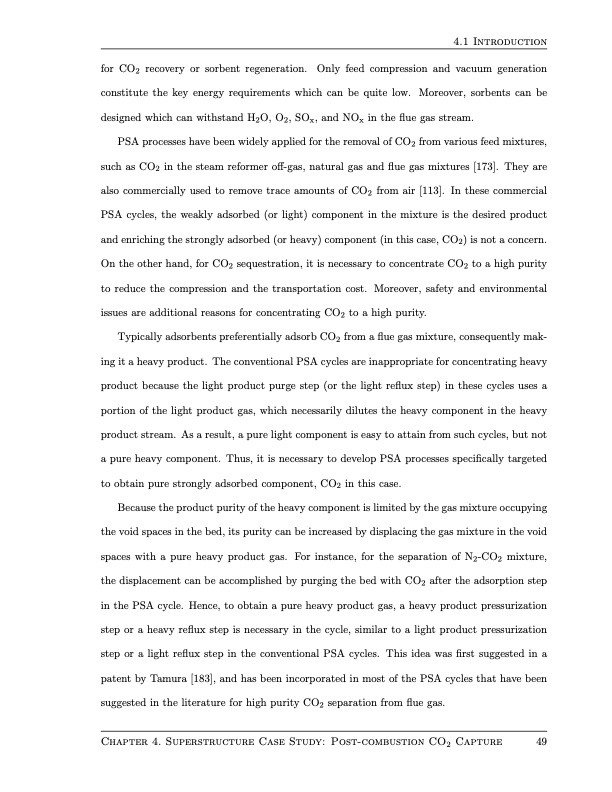
PDF Publication Title:
Text from PDF Page: 063
for CO2 recovery or sorbent regeneration. Only feed compression and vacuum generation constitute the key energy requirements which can be quite low. Moreover, sorbents can be designed which can withstand H2O, O2, SOx, and NOx in the flue gas stream. PSA processes have been widely applied for the removal of CO2 from various feed mixtures, such as CO2 in the steam reformer off-gas, natural gas and flue gas mixtures [173]. They are also commercially used to remove trace amounts of CO2 from air [113]. In these commercial PSA cycles, the weakly adsorbed (or light) component in the mixture is the desired product and enriching the strongly adsorbed (or heavy) component (in this case, CO2) is not a concern. On the other hand, for CO2 sequestration, it is necessary to concentrate CO2 to a high purity to reduce the compression and the transportation cost. Moreover, safety and environmental issues are additional reasons for concentrating CO2 to a high purity. Typically adsorbents preferentially adsorb CO2 from a flue gas mixture, consequently mak- ing it a heavy product. The conventional PSA cycles are inappropriate for concentrating heavy product because the light product purge step (or the light reflux step) in these cycles uses a portion of the light product gas, which necessarily dilutes the heavy component in the heavy product stream. As a result, a pure light component is easy to attain from such cycles, but not a pure heavy component. Thus, it is necessary to develop PSA processes specifically targeted to obtain pure strongly adsorbed component, CO2 in this case. Because the product purity of the heavy component is limited by the gas mixture occupying the void spaces in the bed, its purity can be increased by displacing the gas mixture in the void spaces with a pure heavy product gas. For instance, for the separation of N2-CO2 mixture, the displacement can be accomplished by purging the bed with CO2 after the adsorption step in the PSA cycle. Hence, to obtain a pure heavy product gas, a heavy product pressurization step or a heavy reflux step is necessary in the cycle, similar to a light product pressurization step or a light reflux step in the conventional PSA cycles. This idea was first suggested in a patent by Tamura [183], and has been incorporated in most of the PSA cycles that have been suggested in the literature for high purity CO2 separation from flue gas. 4.1 Introduction Chapter 4. Superstructure Case Study: Post-combustion CO2 Capture 49PDF Image | Design and Operation of Pressure Swing Adsorption Processes

PDF Search Title:
Design and Operation of Pressure Swing Adsorption ProcessesOriginal File Name Searched:
anshul_thesis.pdfDIY PDF Search: Google It | Yahoo | Bing
CO2 Organic Rankine Cycle Experimenter Platform The supercritical CO2 phase change system is both a heat pump and organic rankine cycle which can be used for those purposes and as a supercritical extractor for advanced subcritical and supercritical extraction technology. Uses include producing nanoparticles, precious metal CO2 extraction, lithium battery recycling, and other applications... More Info
Heat Pumps CO2 ORC Heat Pump System Platform More Info
| CONTACT TEL: 608-238-6001 Email: greg@infinityturbine.com | RSS | AMP |